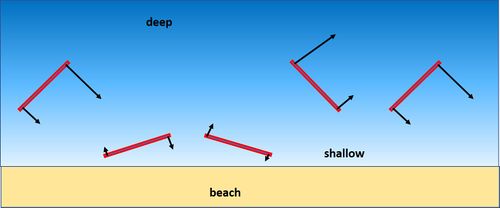Difference between revisions of "Edge waves"
Dronkers J (talk | contribs) |
Dronkers J (talk | contribs) |
||
| Line 1: | Line 1: | ||
| − | |||
{{Definition|title=Edge waves | {{Definition|title=Edge waves | ||
| Line 18: | Line 17: | ||
[[Beach cusps]] along pocket beaches (beaches enclosed between headlands) have sometimes been associated with standing edge waves, resulting from edge wave reflection at the headlands. | [[Beach cusps]] along pocket beaches (beaches enclosed between headlands) have sometimes been associated with standing edge waves, resulting from edge wave reflection at the headlands. | ||
| − | |||
| Line 26: | Line 24: | ||
*[[Surf beat]] | *[[Surf beat]] | ||
*[[Beach Cusps]] | *[[Beach Cusps]] | ||
| + | |||
| + | |||
| + | |||
| + | {{author | ||
| + | |AuthorID=113392 | ||
| + | |AuthorFullName=David Huntley | ||
| + | |AuthorName=Huntley D}} | ||
| + | |||
| + | |||
| + | [[Category:Physical coastal and marine processes]] | ||
| + | [[Category:Beaches]] | ||
| + | [[Category:Hydrodynamics]] | ||
Revision as of 15:58, 18 August 2021
Definition of Edge waves:
Obliquely incident waves trapped to the shore by wave refraction and reflection.
This is the common definition for Edge waves, other definitions can be discussed in the article
|

Notes
Short-period waves dissipate in shallow water when breaking on the shore. However, longer period waves (infragravity waves) that do not break on the shore will be partially reflected. The reflected wave cannot escape to deep water (see the figure) and will travel along the shore as a so-called edge wave. Infragravity waves can gain energy in shallow water by nonlinear interaction processes within wave groups, see Infragravity waves. Infragravity waves can also generated by other causes, see Seiche.
Although generally true that the largest amplitude of edge waves is likely to be shoreward of the breaker line, the form of edge waves is not directly linked to the breaker line: they may decay in amplitude well within the breaking zone or may extend well beyond it. The cross-shore scale of the seaward decay is related to the alongshore wavelength.
The maximum amplitude of an edge wave occurs at the shoreline over a beach that slopes continuously seawards, with an exponential seawards decay over a linearly sloping beach. However over a barred beach the amplitude can become large over the bar crest.
Beach cusps along pocket beaches (beaches enclosed between headlands) have sometimes been associated with standing edge waves, resulting from edge wave reflection at the headlands.
See also
Please note that others may also have edited the contents of this article.
|